Food Manufacturer Financial Model
Financial Model for a Food Manufacturer
Covering key components such as the Income Statement, Cash Flow Statement, and Balance Sheet.
Income Statement (Profit & Loss Statement)
The Income Statement outlines the company’s revenue, expenses, and profitability over a given period.
A. Revenue (Top Line)
- Sales Revenue – Revenue from selling food products, categorized by:
- Wholesale sales (bulk supply to retailers)
- Direct-to-consumer sales (e.g., online, factory stores)
- Institutional sales (restaurants, hotels, etc.)
- Other Revenue – Any additional revenue, such as:
- Private label manufacturing (producing for other brands)
- Licensing or franchising fees
- Income from by-products (e.g., selling food waste for animal feed)
B. Cost of Goods Sold (COGS)
- Raw Materials – Costs of ingredients (flour, sugar, meat, dairy, etc.)
- Packaging Materials – Costs of plastic, glass, metal, or paper packaging
- Direct Labor – Wages for production line workers
- Factory Overheads – Utilities, maintenance, and equipment depreciation
- Freight & Distribution Costs – Shipping costs to retailers or customers
C. Gross Profit
Gross Profit = Revenue – COGS
D. Operating Expenses
- Selling & Marketing Expenses – Advertising, branding, promotions
- General & Administrative (G&A) Expenses – Salaries, rent, office expenses
- Research & Development (R&D) – New product development costs
- Depreciation & Amortization – Equipment and intangible asset write-offs
E. Operating Profit (EBIT)
Operating Profit = Gross Profit – Operating Expenses
F. Other Income & Expenses
- Interest Income – Earnings from excess cash or investments
- Interest Expense – Loan and credit interest costs
- Non-Operating Expenses – Legal settlements, fines, etc.
G. Net Profit Before Tax
EBT (Earnings Before Tax) = Operating Profit + Other Income – Other Expenses
H. Taxes
- Corporate tax
- Deferred tax adjustments
I. Net Profit (Bottom Line)
Net Profit = EBT – Taxes
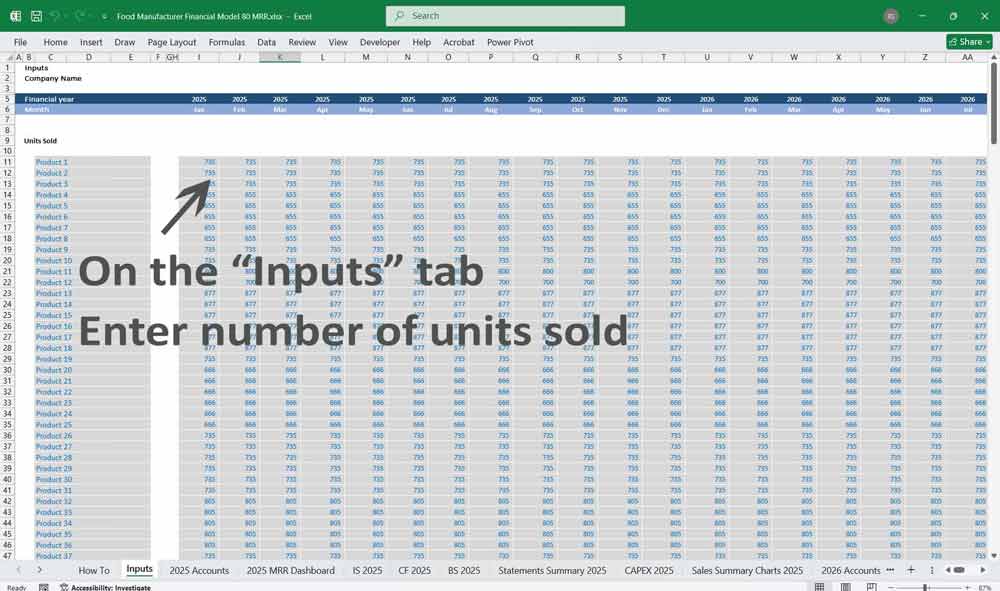
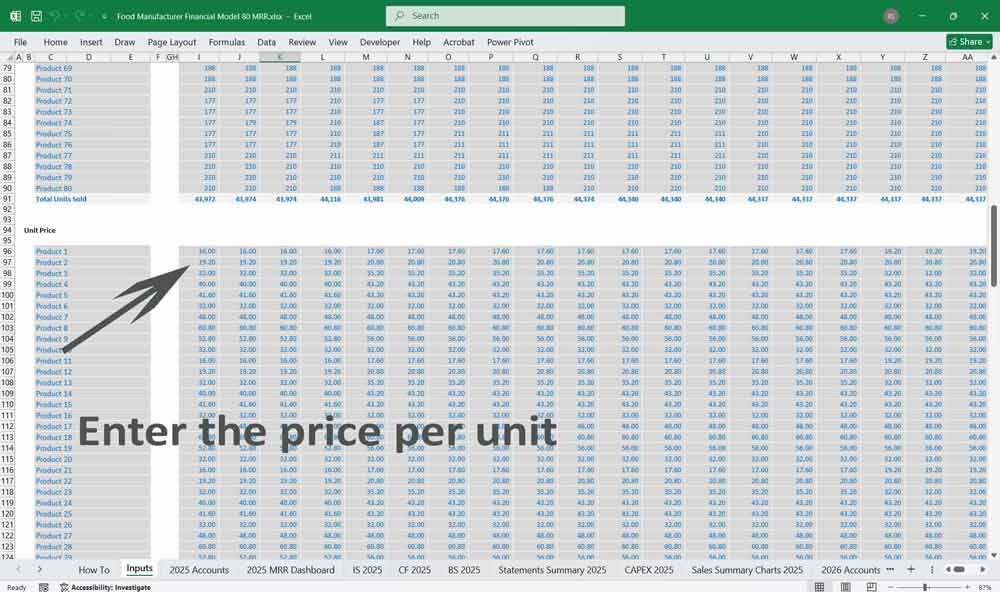
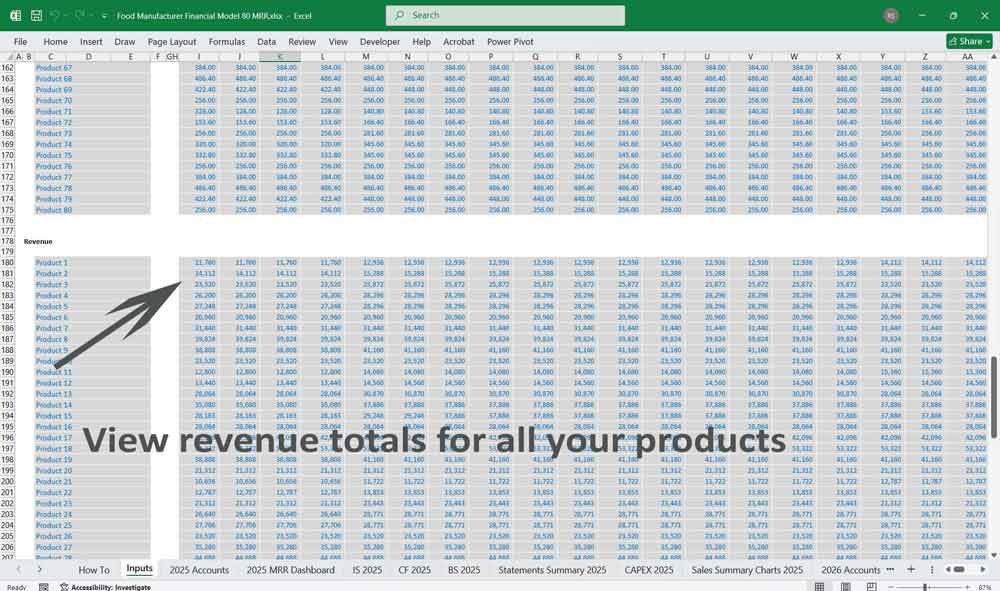
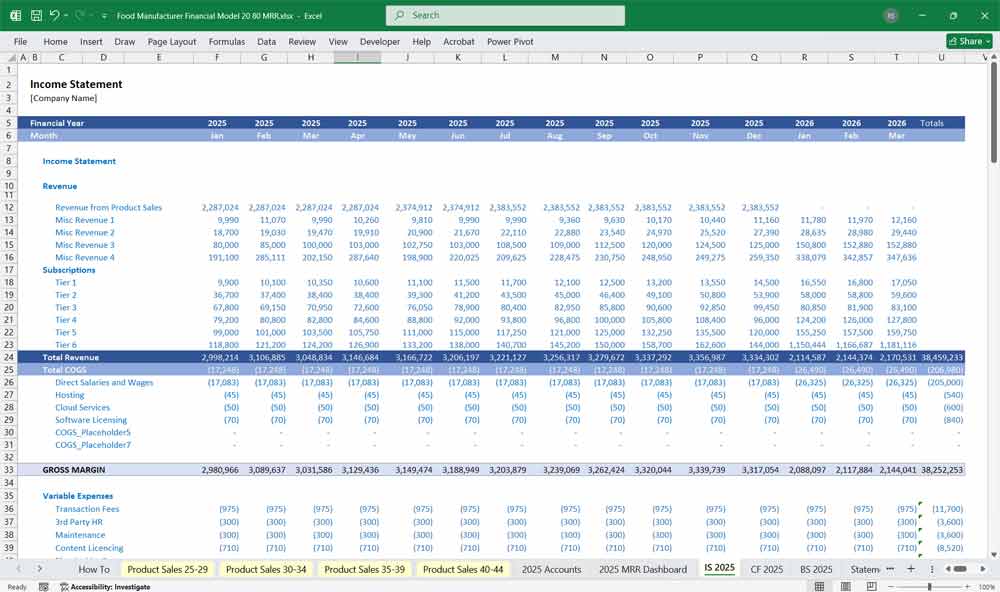
Food Manufacturer Cash Flow Statement
The Cash Flow Statement tracks how cash moves through the business.
A. Cash Flow from Operating Activities
- Net Profit (from Income Statement)
- Adjustments for Non-Cash Items
- Depreciation & Amortization
- Changes in deferred taxes
- Changes in Working Capital
- Increase/decrease in inventory
- Increase/decrease in accounts receivable
- Increase/decrease in accounts payable
B. Cash Flow from Investing Activities
- Capital Expenditures (CapEx) – Purchase of machinery, factory upgrades
- Acquisition of Assets – Buying land, buildings, or intellectual property
- Investments in Other Businesses – Mergers, partnerships, equity stakes
- Proceeds from Sale of Assets – Selling unused equipment or property
C. Cash Flow from Financing Activities
- New Loans or Debt Issuance – Bank loans, bonds
- Loan Repayments – Paying down existing debt
- Equity Financing – Issuing new shares
- Dividend Payments – Cash paid to shareholders
- Stock Buybacks – Repurchasing shares from the market
D. Net Increase/Decrease in Cash
Final cash position based on operational, investing, and financing activities.
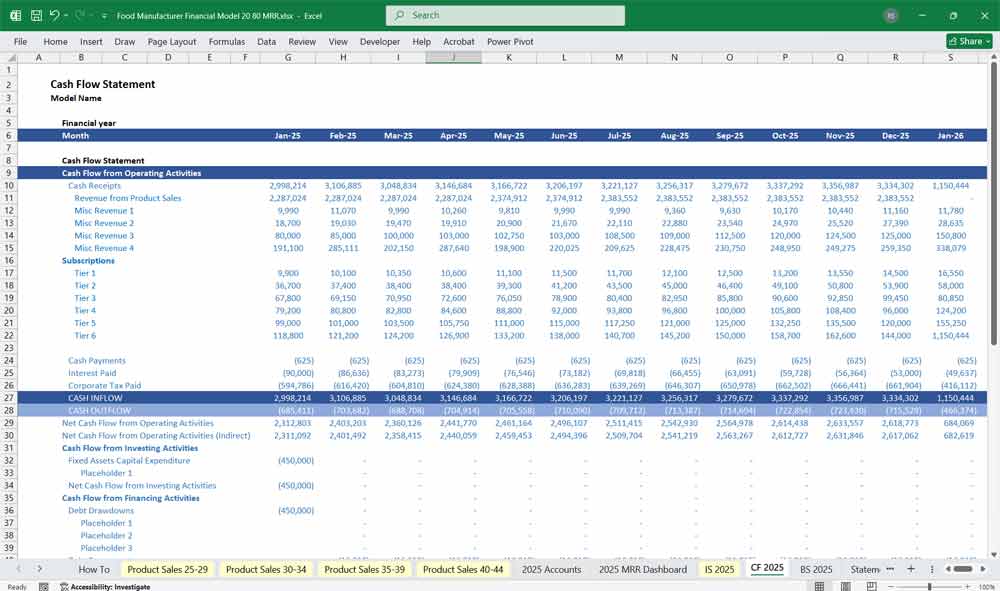
Food Manufacturer Balance Sheet
The Balance Sheet provides a snapshot of the company’s financial position.
A. Assets
Current Assets
- Cash & Cash Equivalents
- Accounts Receivable (money owed by customers)
- Inventory (raw materials, work-in-progress, finished goods)
- Prepaid Expenses (rent, insurance, etc.)
Non-Current Assets
- Property, Plant, & Equipment (PP&E) – Factories, machines, vehicles
- Intangible Assets – Trademarks, patents, goodwill
- Investments – Equity in other companies, bonds
B. Liabilities
Current Liabilities
- Accounts Payable (supplier bills)
- Short-Term Debt (loans due within a year)
- Accrued Expenses (salaries, utilities, taxes)
- Deferred Revenue (advance payments from customers)
Non-Current Liabilities
- Long-Term Debt (bank loans, bonds)
- Pension & Retirement Liabilities
- Deferred Tax Liabilities
C. Equity (Shareholders’ Funds)
- Common Stock & Additional Paid-In Capital – Investments from owners
- Retained Earnings – Cumulative profits reinvested in the business
- Treasury Stock – Company’s repurchased shares
D. Total Liabilities & Equity
Assets = Liabilities + Equity (must always balance).

Key Financial Metrics for a Food Manufacturer
- Gross Margin = Gross Profit / Revenue
- Operating Margin = Operating Profit / Revenue
- Net Profit Margin = Net Profit / Revenue
- Current Ratio = Current Assets / Current Liabilities (Liquidity Measure)
- Debt-to-Equity Ratio = Total Debt / Total Equity (Leverage Measure)
- Return on Assets (ROA) = Net Profit / Total Assets (Efficiency)
- Return on Equity (ROE) = Net Profit / Equity (Shareholder Return)
These 40 and 80-product line sections can be edited based on the manufacturer’s specific product offerings, target market, and production capabilities.
Product Line Examples
This Food Manufacturer Financial Model version is ideal for a mid-sized food manufacturer with a focused product range. The sections can be divided into 4 main categories, with 10 products per category:
Snacks & Confectionery Food
Potato Chips (Various Flavors)
Chocolate Bars
Granola Bars
Pretzels
Popcorn
Candy Gummies
Nut Mixes
Rice Cakes
Fruit Snacks
Energy Bites
Bakery & Breakfast Food Items
Bread Loaves (Whole Grain, White, Multigrain)
Bagels
Muffins
Croissants
Pancake Mix
Waffles
Cereal Bars
Donuts
Cookies (Chocolate Chip, Oatmeal, etc.)
Pastries
Frozen Food
Frozen Pizza
Frozen Vegetables
Frozen Fruits
Ice Cream
Frozen Meals (Pasta, Stir-Fry, etc.)
Frozen Desserts
Frozen Breakfast Sandwiches
Frozen Dumplings
Frozen Fish Sticks
Frozen Smoothie Packs
Food Beverages & Condiments
Fruit Juices
Energy Drinks
Bottled Water
Coffee Pods
Tea Bags
Ketchup
Mustard
Salad Dressings
Hot Sauce
Syrups (Maple, Chocolate, etc.)
80 Product Line Version
This version is suitable for a larger food manufacturer with a diverse product portfolio. The sections can be divided into 8 main categories, with 10 products per category:
Snacks & Confectionery Food
Potato Chips (Various Flavors)
Tortilla Chips
Chocolate Bars
Granola Bars
Pretzels
Popcorn
Candy Gummies
Nut Mixes
Rice Cakes
Fruit Snacks
Bakery & Breakfast Food Items
Bread Loaves (Whole Grain, White, Multigrain)
Bagels
Muffins
Croissants
Pancake Mix
Waffles
Cereal Bars
Donuts
Cookies (Chocolate Chip, Oatmeal, etc.)
Pastries
Frozen Foods
Frozen Pizza
Frozen Vegetables
Frozen Fruits
Ice Cream
Frozen Meals (Pasta, Stir-Fry, etc.)
Frozen Desserts
Frozen Breakfast Sandwiches
Frozen Dumplings
Frozen Fish Sticks
Frozen Smoothie Packs
Beverages & Food Liquids
Fruit Juices
Energy Drinks
Bottled Water
Coffee Pods
Tea Bags
Ketchup
Mustard
Salad Dressings
Hot Sauce
Syrups (Maple, Chocolate, etc.)
Canned & Packaged Food
Canned Vegetables
Canned Fruits
Canned Soups
Canned Beans
Pasta Sauce
Jarred Pickles
Jarred Olives
Packaged Noodles
Instant Rice
Packaged Grains (Quinoa, Couscous, etc.)
Dairy Food & Alternatives
Milk (Cow, Almond, Soy, Oat)
Cheese Slices
Yogurt
Butter
Cream Cheese
Sour Cream
Plant-Based Cheese
Plant-Based Yogurt
Whipped Cream
Ice Cream
Meat & Plant-Based Food Proteins
Chicken Breasts
Ground Beef
Plant-Based Burgers
Sausages
Bacon
Deli Meats
Plant-Based Chicken
Fish Fillets
Tofu
Tempeh
Specialty & International Food
Salsa
Hummus
Guacamole
Curry Pastes
Soy Sauce
Teriyaki Sauce
Pesto
Kimchi
Sushi Rice
Tortillas
By expanding from 40 to 80 product lines, the manufacturer can capture a larger share of the market, cater to diverse industries, and offer more specialized solutions, while also increasing operational complexity and requiring greater investment in R&D and supply chain management.
6-tier subscription model for a food manufacturer
This involves structuring offerings that cater to different customer segments, from small businesses to large enterprises. Each tier should provide increasing value, services, and benefits to justify the higher price points.
Tier 1 – Starter Food Pack
Target Audience: First-time customers, budget-conscious buyers.
Features:
- Monthly delivery of 3-5 core products (e.g., snacks, sauces, or meal kits).
- Smaller portion sizes, sample packs.
- Access to basic recipes & usage guides.
- 5% discount on additional online purchases.
Pricing:
- $10 – $20/month
- Free shipping on orders above a set amount ($50+).
Value Proposition:
- Encourages trial with low-cost entry.
- Introduces new customers to the brand.
Tier 2 – Everyday Foods
Target Audience: Small households, individuals looking for regular supplies.
Features:
- Monthly delivery of 6-10 essential products (e.g., pantry staples, sauces, snacks).
- Slightly larger pack sizes than Tier 1.
- 10% discount on all additional online purchases.
- Early access to new product releases.
- Access to exclusive recipes & meal plans.
Pricing:
- $25 – $40/month
- Free shipping included.
Value Proposition:
- Covers everyday food needs with convenience.
- Encourages customer loyalty with discount incentives.
Tier 3 – Household Favorite Food
Target Audience: Families, bulk buyers.
Features:
- Monthly delivery of 12-15 products, larger-sized packs.
- Customizable product selection (choose from 20+ items).
- Exclusive family meal kits with easy-to-make recipes.
- 15% discount on additional online purchases.
- Monthly bonus product (seasonal or limited edition).
- Priority customer support.
Pricing:
- $50 – $75/month
- Free shipping included.
Value Proposition:
- Ideal for families who cook frequently.
- Bulk savings and flexibility in product selection.
Tier 4 – Gourmet Food Experience
Target Audience: Food enthusiasts, health-conscious consumers.
Features:
- Monthly delivery of 10-12 premium, organic, or specialty products.
- Exclusive gourmet and artisanal products (e.g., organic sauces, limited-edition items).
- 20% discount on all additional online purchases.
- Free access to virtual cooking classes.
- Behind-the-scenes factory tour (1x per year).
- Personalized dietary preference options (vegan, gluten-free, keto).
Pricing:
- $100 – $150/month
- Free shipping included.
Value Proposition:
- Premium ingredients and unique products for food lovers.
- Engages customers with experiences, not just food.
Tier 5 – Wholesale Food & Small Business Package
Target Audience: Small businesses, cafes, restaurants, food service providers.
Features:
- Monthly delivery of bulk-size ingredients or wholesale products.
- Flexible order customization (choose from 50+ items).
- 30% discount on additional bulk purchases.
- Dedicated account manager for business support.
- Access to wholesale-only exclusive product lines.
- White-label/private-label options for reselling.
Pricing:
- $250 – $500/month
- Volume-based pricing model.
Value Proposition:
- Helps small businesses save on quality food ingredients.
- Provides business support & customization.
Tier 6 – Enterprise & Bulk Food Solutions
Target Audience: Large restaurants, catering businesses, hotels, institutional buyers.
Features:
- Monthly delivery of large-volume wholesale food products.
- Custom manufacturing & white-label options.
- 40% discount on additional bulk purchases.
- Personalized R&D collaboration for exclusive recipes.
- Dedicated logistics & fulfillment support.
- On-site quality assurance & factory visits.
Pricing:
- $1,000+ per month (custom pricing based on volume).
- Contract-based pricing.
Value Proposition:
- Tailored solutions for high-volume buyers.
- Scalability & reliability for large businesses.

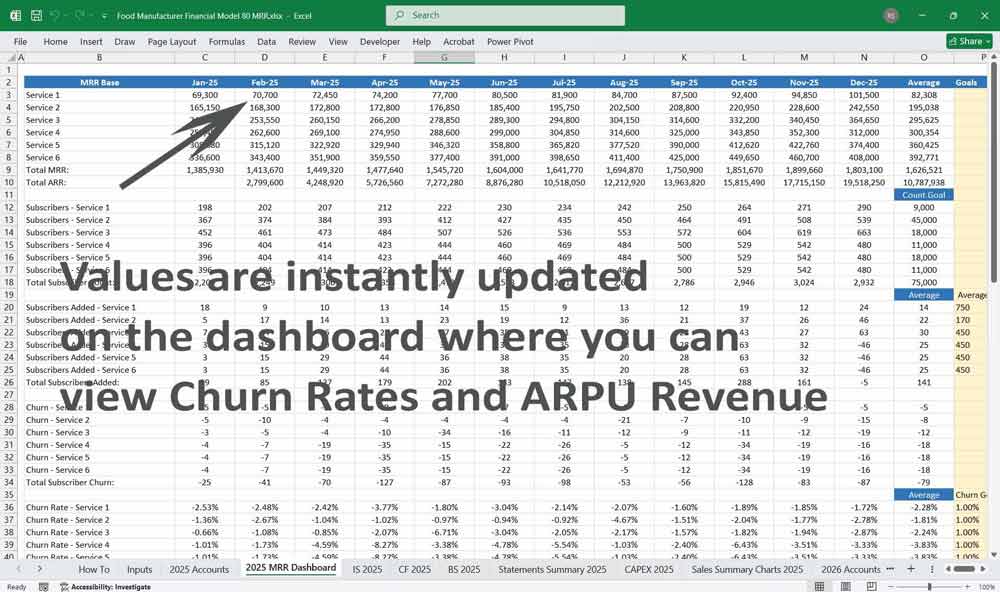
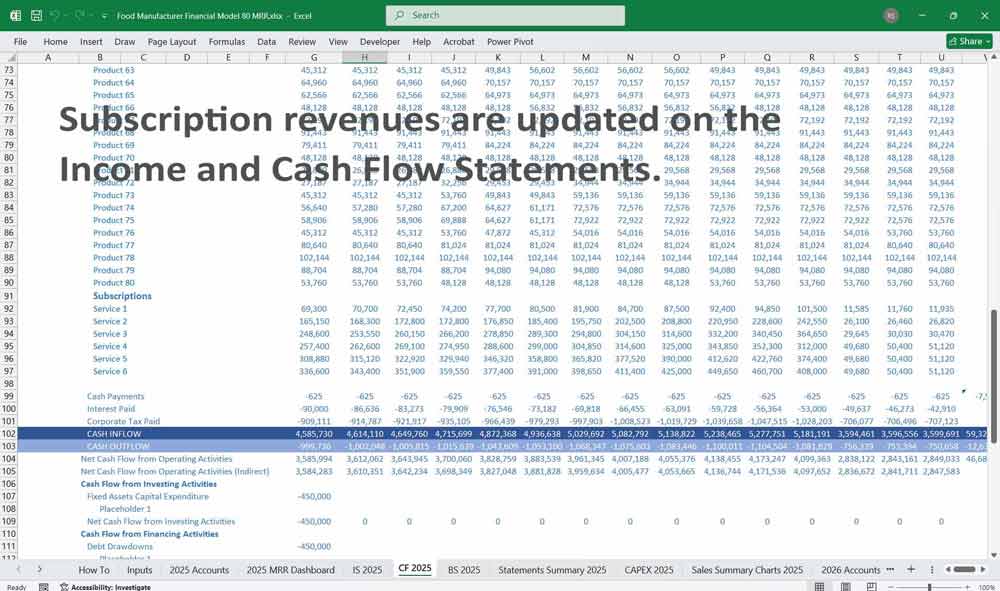

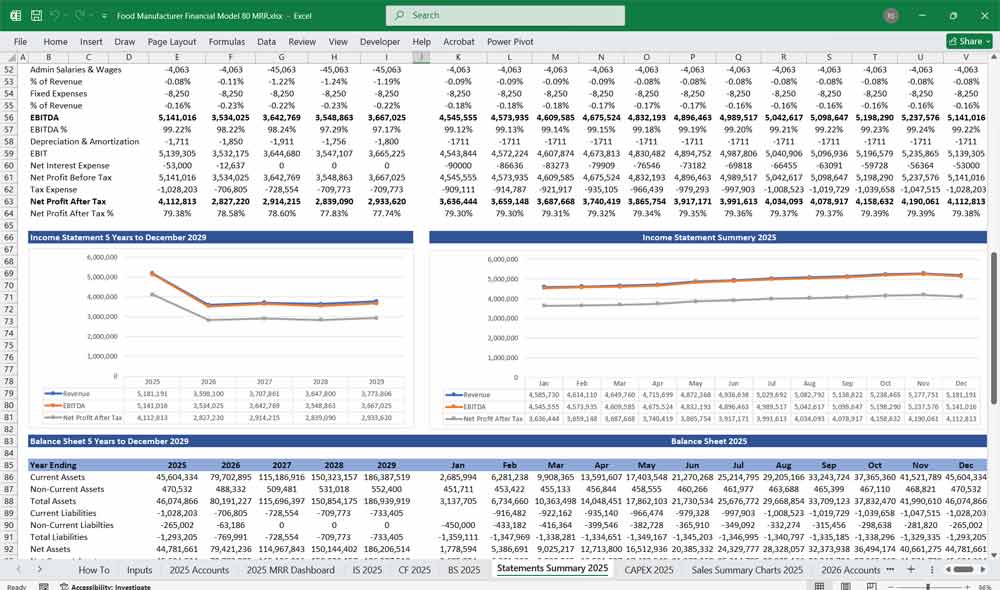
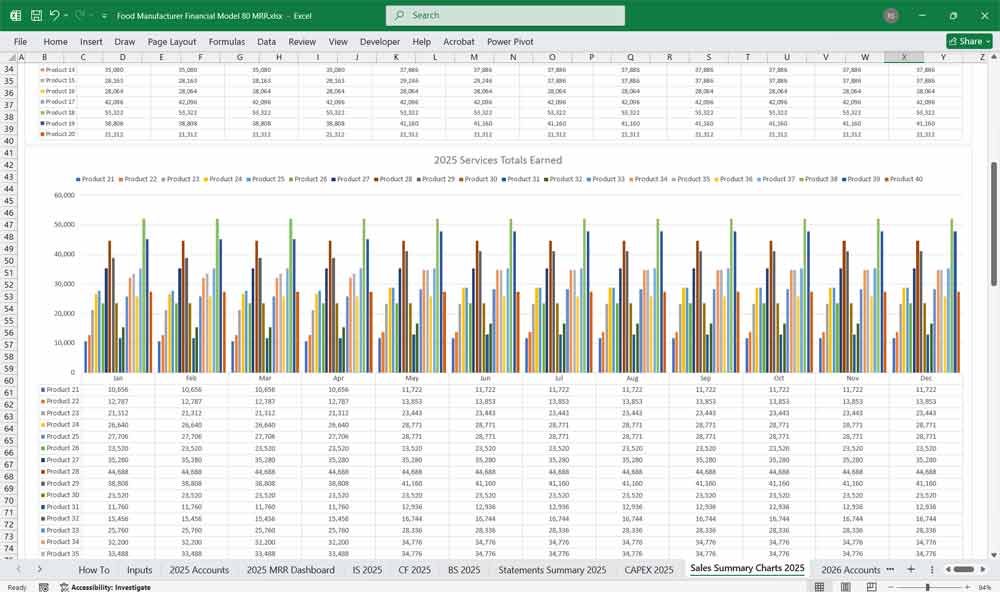

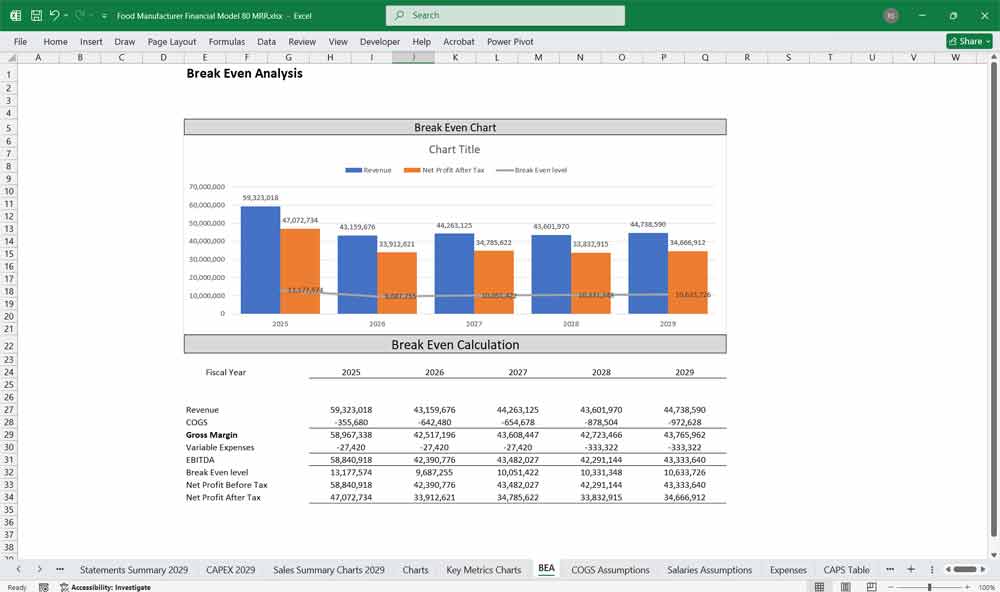
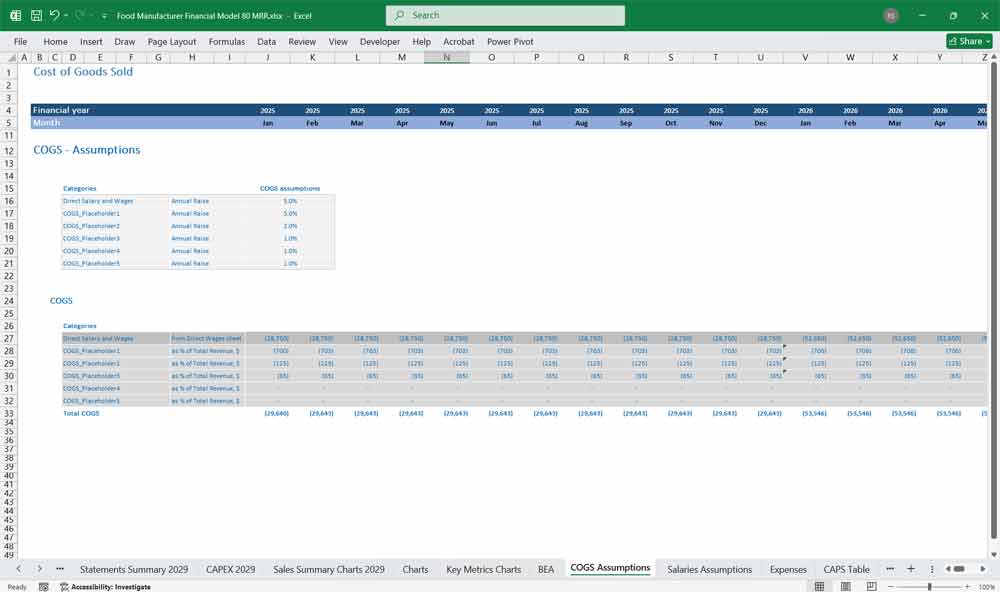
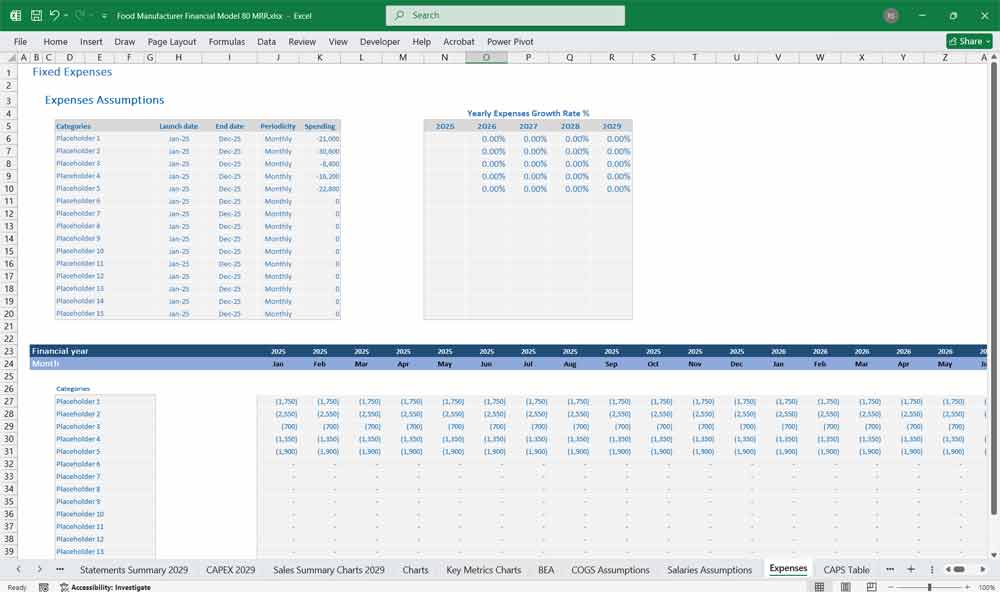

Final Notes on the 20-Year Financial Model
Financial model for a Food manufacturer
- Scenario Analysis: Create best-case, base-case, and worst-case projections.
- Break-even Analysis: Determine sales volume required to cover fixed & variable costs.
- Sensitivity Analysis: Assess how changes in raw material costs, pricing, or demand impact profitability.
This structured model helps a Food manufacturing company address a broad market spectrum, offering the right balance between cost, production capacity, and support.
Download Link On Next Page
